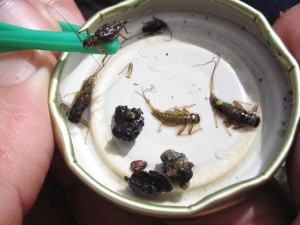We had been on the water for a couple of hours, when we ran into two frequent visitors to the Mitta River and – as you do – we asked what flies they were using and if they’d had any luck.
“They’re biting on caddis at the moment,” we were told, and shown a small fluffy greenish curved hook fly which could have been a green rock worm or a maybe even a small cased caddis. Frankly, it looked like a small ball of green snot.
“Yeah, we come here all the time and we’ve got used to what’s they’re biting, so that’s it”, we were told, with some confidence. And off they went, with their little balls of snot, without asking us what we were using.
Without this level of either experience or confidence, we’d arrived early and turned over a few rocks. We like turning over rocks, taking the water temperature, checking the lunar cycle and … well … turning over rocks.

We check the moon to see if it was bright the night before to see if the trout were feeding into the night and likely to be less hungry during the day. If there was a full moon and the water temperature near the surface is creeping up above 19 degrees, we set our flies for down deep.
If we feel a certain mugginess coming on, and start to see some birds working the surface of the water, we start looking for signs of a hatch. My mate Warwick also starts looking for stonefly casings stuck to overhanging branches or streamside rocks.
But turning over the rocks in the water is fundamental. We don’t start fishing until we’ve done it. It took us ten years to learn how important it was and since then, we’ve since stuck to it. We pick a fast moving patch of water, a riffle and a slow moving part. We’re looking for the basics: Mayflies, Caddis, including Green Rock Worms and Stoneflies. We look for clinger mayfly numbers in the fast water and swimmers in the slow. In the slow water we also check for big burrower mayfly nymphs and muddlers. We’re not insect experts, but we know what trout like.
On the day in question, we’d turned over a lot of rocks and found a smorgasbord of nymphs and pupae – including some smaller cased caddis and some small green pupae. So the visiting experts were indeed partly on the right track.
But we also found a lot of size ten cased caddis … nice and brown, with the casing made of some local vegetation, which looked pretty appetising and digestible for a hungry trout.
We love to collect flies from web sites and fly shops around the world and experiment with them wherever we can, so I had a couple of flies which matched this description perfectly and I tied one on and set the depth to bump along the bottom, just below faster moving water which could have dislodged the little darlings.
I then had one of those purple patches which I’ve previously only read about, but never experienced: every cast I had, I had a hook up. The trout just loved it. It was the best afternoon’s fishing I’ve had on the Mitta and it drove Warwick crazy. He only started smiling again, after I’d lost both flies and the playing field levelled out somewhat.
The moral to the story is as basic to fly fishing as it is to demographic profiling, which is how we earn the money to go fly fishing in the first place, and that is, even if you think you know everything, don’t start fishing until you’ve turned over a few rocks.
PICTURE: The picture above shows a mean little black stonefly on the tweezers and three mayfly nymphs of varying sizes. The flatter ones with the wider heads are clingers, so named because they cling to the bottom of rock in fast water. The little bundles of pebbles are rock cased caddis. Picture by Warwick Powell.